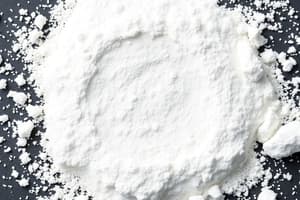Podcast
Questions and Answers
Which characteristic is NOT true for pure substances?
Which characteristic is NOT true for pure substances?
- Have consistent properties
- Cannot be broken down into simpler substances
- Can be separated by physical means (correct)
- Have a uniform composition
Which of the following is an example of a compound?
Which of the following is an example of a compound?
- Oxygen
- Salt (correct)
- Iron
- Gold
Which property is NOT associated with metals?
Which property is NOT associated with metals?
- Lustrous
- Malleable
- Are poor conductors of heat (correct)
- Conduct heat and electricity
What primarily distinguishes metalloids from metals?
What primarily distinguishes metalloids from metals?
Which of the following describes elements?
Which of the following describes elements?
Which of the following is a property of non-metals?
Which of the following is a property of non-metals?
What defines a mixture?
What defines a mixture?
Which of the following is NOT a property of metals?
Which of the following is NOT a property of metals?
What defines a compound in terms of its components?
What defines a compound in terms of its components?
Which of the following statements about water is correct?
Which of the following statements about water is correct?
How can the components of a compound be separated?
How can the components of a compound be separated?
What is a homogeneous mixture?
What is a homogeneous mixture?
Which of the following is NOT a characteristic property of mixtures?
Which of the following is NOT a characteristic property of mixtures?
Which of the following best describes a heterogeneous mixture?
Which of the following best describes a heterogeneous mixture?
What ratio of hydrogen to oxygen atoms is found in water?
What ratio of hydrogen to oxygen atoms is found in water?
What would happen if two elements are mixed but not chemically combined?
What would happen if two elements are mixed but not chemically combined?
What defines a compound in contrast to a mixture?
What defines a compound in contrast to a mixture?
Which of the following accurately describes the composition of mixtures?
Which of the following accurately describes the composition of mixtures?
Which method is used to separate the components of a compound?
Which method is used to separate the components of a compound?
Which of the following properties applies to compounds?
Which of the following properties applies to compounds?
What distinguishes homogeneous mixtures from heterogeneous mixtures?
What distinguishes homogeneous mixtures from heterogeneous mixtures?
Which statement is true regarding alloys?
Which statement is true regarding alloys?
Why are solutions classified as homogeneous mixtures?
Why are solutions classified as homogeneous mixtures?
What is a common characteristic of colloids?
What is a common characteristic of colloids?
What is the correct definition of a solvent?
What is the correct definition of a solvent?
What does solubility refer to in a solution?
What does solubility refer to in a solution?
In an solution of 80% ethyl alcohol with 20% water, what is the solute?
In an solution of 80% ethyl alcohol with 20% water, what is the solute?
When 36g of sodium chloride is dissolved in 100g of water at 293 K, which type of solution is created?
When 36g of sodium chloride is dissolved in 100g of water at 293 K, which type of solution is created?
What would happen to a saturated solution of potassium chloride when cooled to room temperature?
What would happen to a saturated solution of potassium chloride when cooled to room temperature?
Which of the following best describes an unsaturated solution?
Which of the following best describes an unsaturated solution?
In terms of mass by mass percentage concentration, if a solution contains 60 g of sugar in 480 g of water, what is the concentration?
In terms of mass by mass percentage concentration, if a solution contains 60 g of sugar in 480 g of water, what is the concentration?
What effect does increasing temperature generally have on the solubility of solids in liquids?
What effect does increasing temperature generally have on the solubility of solids in liquids?
Which statement best describes the nature of a colloid?
Which statement best describes the nature of a colloid?
What phenomenon describes the scattering of light by colloidal particles?
What phenomenon describes the scattering of light by colloidal particles?
Which of the following is a characteristic of a suspension?
Which of the following is a characteristic of a suspension?
What is the main difference between physical and chemical changes?
What is the main difference between physical and chemical changes?
Which of the following examples best represents an emulsion?
Which of the following examples best represents an emulsion?
Which type of colloid consists of a gas dispersed in a solid?
Which type of colloid consists of a gas dispersed in a solid?
Which of the following statements about dispersed phases and dispersion mediums is true?
Which of the following statements about dispersed phases and dispersion mediums is true?
What feature distinguishes a colloid from a solution and a suspension?
What feature distinguishes a colloid from a solution and a suspension?
Which of the following examples represents a chemical change?
Which of the following examples represents a chemical change?
Which statement is true regarding physical changes?
Which statement is true regarding physical changes?
Which of the following scenarios demonstrates a situation that cannot be reversed?
Which of the following scenarios demonstrates a situation that cannot be reversed?
Which of the following is an example of a substance that is in a solid state at room temperature?
Which of the following is an example of a substance that is in a solid state at room temperature?
Which combination correctly identifies a mixture?
Which combination correctly identifies a mixture?
What is a characteristic of chemical changes compared to physical changes?
What is a characteristic of chemical changes compared to physical changes?
Which of the following processes is not a physical change?
Which of the following processes is not a physical change?
Which of the following statements about pure substances is accurate?
Which of the following statements about pure substances is accurate?
Flashcards
What is a pure substance?
What is a pure substance?
A substance that is made of only one type of atom or molecule, with a uniform and definite composition, and cannot be separated into other types of matter by physical means.
What is an element?
What is an element?
A pure substance that cannot be broken down into simpler substances by chemical reactions.
What is a compound?
What is a compound?
A pure substance formed when two or more elements combine chemically in a fixed ratio.
What is a mixture?
What is a mixture?
Signup and view all the flashcards
What is a solution?
What is a solution?
Signup and view all the flashcards
What is the concentration of a solution?
What is the concentration of a solution?
Signup and view all the flashcards
What is a physical change?
What is a physical change?
Signup and view all the flashcards
What is a chemical change?
What is a chemical change?
Signup and view all the flashcards
How do compound properties differ from their elements?
How do compound properties differ from their elements?
Signup and view all the flashcards
How are compounds broken down?
How are compounds broken down?
Signup and view all the flashcards
What is a Homogeneous Mixture?
What is a Homogeneous Mixture?
Signup and view all the flashcards
What is a heterogeneous Mixture?
What is a heterogeneous Mixture?
Signup and view all the flashcards
How are components in homogenous mixtures separated?
How are components in homogenous mixtures separated?
Signup and view all the flashcards
How are components in heterogeneous mixtures separated?
How are components in heterogeneous mixtures separated?
Signup and view all the flashcards
What is a true solution?
What is a true solution?
Signup and view all the flashcards
What is a colloid?
What is a colloid?
Signup and view all the flashcards
What is a suspension?
What is a suspension?
Signup and view all the flashcards
Solvent
Solvent
Signup and view all the flashcards
Solute
Solute
Signup and view all the flashcards
Concentration of a solution
Concentration of a solution
Signup and view all the flashcards
Solubility
Solubility
Signup and view all the flashcards
Saturated solution
Saturated solution
Signup and view all the flashcards
Unsaturated solution
Unsaturated solution
Signup and view all the flashcards
Colloidal solution
Colloidal solution
Signup and view all the flashcards
Dispersed Phase
Dispersed Phase
Signup and view all the flashcards
Dispersion Medium
Dispersion Medium
Signup and view all the flashcards
What is the Tyndall Effect?
What is the Tyndall Effect?
Signup and view all the flashcards
How does Physical Change affect a substance?
How does Physical Change affect a substance?
Signup and view all the flashcards
What are physical changes?
What are physical changes?
Signup and view all the flashcards
What are chemical changes?
What are chemical changes?
Signup and view all the flashcards
Is burning a candle a physical or chemical change?
Is burning a candle a physical or chemical change?
Signup and view all the flashcards
What is Tyndall Effect?
What is Tyndall Effect?
Signup and view all the flashcards
Characteristics of Pure Substances
Characteristics of Pure Substances
Signup and view all the flashcards
Product of a chemical reaction
Product of a chemical reaction
Signup and view all the flashcards
Study Notes
Matter Classification
- Matter is anything that occupies space and has mass
- Matter can be classified as pure substances or mixtures
- Pure substances are made of only one type of atom or molecule
- Mixtures contain two or more substances that are not chemically bonded
Pure Substances
- Pure substances have a fixed composition
- They cannot be separated into simpler substances by physical means, like filtration or distillation
- Examples include elements and compounds
Elements
- Elements are the simplest form of matter
- They cannot be broken down into simpler substances by chemical reactions
- Elements are made up of only one type of atom
- Examples of elements include gold (Au), sodium (Na), iron (Fe)
- Elements are further classified as metals, nonmetals, and metalloids
Metals
- Metals are typically solids at room temperature
- They are good conductors of heat and electricity
- They are malleable (can be hammered into sheets) and ductile (can be drawn into wires)
- They have a shiny luster or are lustrous
- Examples of metals include iron, copper, gold, and silver
Nonmetals
- Nonmetals are not good conductors of heat and electricity
- They are typically not malleable or ductile
- They may be solids, liquids or gases at room temperature
- Examples include hydrogen (H), oxygen (O), nitrogen (N), chlorine (Cl)
Metalloids
- Metalloids have properties that are intermediate between metals and nonmetals
- They can be lustrous or dull
- They are semiconductors (conduct electricity better than nonmetals but not as well as metals)
- Examples of metalloids include boron (B), silicon (Si), and germanium (Ge)
Compounds
- Compounds are formed when two or more elements combine chemically in a fixed ratio
- They have different properties from the elements they are made of
- Examples of compounds include water (H₂O), sodium chloride (NaCl), and carbon dioxide (CO₂)
Mixtures
- Mixtures are formed when two or more substances are mixed together physically, without any chemical reaction
- Mixtures do not have a fixed composition and their properties depend on the proportion of the components
- Mixtures can be homogeneous or heterogeneous
Homogeneous Mixtures
- Homogeneous mixtures have uniform composition throughout
- The components are not easily distinguishable
- Examples include saltwater solutions, sugar dissolved in water, air
Heterogeneous Mixtures
- Heterogeneous mixtures have non-uniform composition
- The components are easily distinguishable
- Examples include sand and water, oil and water, a salad
Solutions
- Solutions are homogeneous mixtures of a solute and a solvent
- The solute is the substance that is dissolved, and the solvent is the substance that dissolves the solute
- Examples of solutions include saltwater, sugar water, and air
Concentration of a Solution
- Concentration measures the amount of solute present in a given amount of solution
- Different units for concentration exist, such as mass percentage, volume percentage and molarity
Solubility
- Solubility is the maximum amount of a solute that can dissolve in a given amount of solvent at a specific temperature
- Solubility can be affected by temperature
Colloids
- Colloids are heterogeneous mixtures with particles of intermediate size between solutions and suspensions
- Colloidal particles do not settle out over time and scatter light (Tyndall effect)
- Examples include milk, fog, and smoke
Suspensions
- Suspensions are heterogeneous mixtures with large, visible particles suspended in a liquid or gas
- The particles settle out over time
- Examples include muddy water and sand in water
Properties of Matter
-
Physical changes do not alter the identity of a substance
-
Chemical changes create new substances
-
Examples of physical changes include melting, freezing, dissolving
-
Examples of chemical changes include combustion and oxidation
The Tyndall Effect
- The Tyndall effect is the scattering of light by colloidal particles
- The scattering of light is due to the difference in the size of the particles of the colloid and the wavelength of light
Classification Examples
- Classify sodium, soil, sugar solution, silver, calcium carbonate, tin, silicon, coal, air, soap, methane, carbon dioxide, and blood into elements, compounds, and mixtures.
Alloy
- Examples of alloys are mixtures of different metals
- An example of an alloy is brass, which is a mixture of zinc and copper
Studying That Suits You
Use AI to generate personalized quizzes and flashcards to suit your learning preferences.




